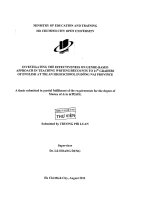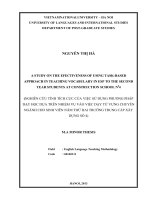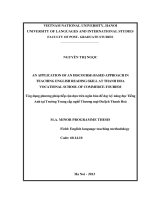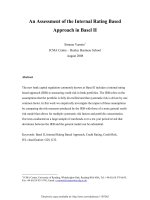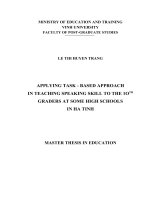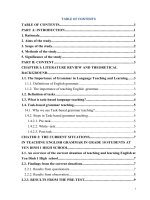Teachers perspectives of theme based approach in high schools in dalat city, lam dong province master of TESOL
Bạn đang xem bản rút gọn của tài liệu. Xem và tải ngay bản đầy đủ của tài liệu tại đây (963.89 KB, 127 trang )
MINISTRY OF EDUCATION AND TRAINING
BA RIA VUNG TAU UNIVERSITY
---------------
TOPIC
TEACHERS’ PERSPECTIVES OF THEME-BASED
APPROACH IN HIGH SCHOOLS IN DALAT CITY,
LAM DONG PROVINCE
BY TRAN THI THANH THUY
Student’s code: 18110094
Supervised by: DUONG MY THAM, Ph.D.
VUNG TAU, MARCH 2022
MINISTRY OF EDUCATION AND TRAINING
BA RIA VUNG TAU UNIVERSITY
---------------
TOPIC
TEACHERS’ PERSPECTIVES OF THEME-BASED
APPROACH IN HIGH SCHOOLS IN DALAT CITY,
LAM DONG PROVINCE
BY TRAN THI THANH THUY
Student’s code: 18110094
Supervised by: DUONG MY THAM, Ph.D.
VUNG TAU, MARCH 2022
MINISTRY OF EDUCATION AND TRAINING
BA RIA VUNG TAU UNIVERSITY
Vung Tau, 30th March 2022
MASTER’S THESIS REPORT
Student’s name: TRAN THI THANH THUY
Sex: Female
Date of birth: 11/02/1985
Place of birth: Lam Dong
Major:
Student code: 18110094
TESOL
I- Thesis title:
Teachers’ perspectives of theme-based approach in high schools in Da Lat City,
Lam Dong province
II- Objectives and contents:
The overall objectives of the current study are to investigate EFL teachers’
perceptions of implementing the theme-based approach at Dalat City-based high
schools, whether there are significant differences in terms of perceptions of the
theme-based approach between trained EFL teachers and untrained EFL teachers at
Dalat City-based high schools, the challenges EFL teachers encounter when TBA is
implemented at Dalat City-based high schools.
III- Starting date: 01/08/2021
IV- Completing date: 30/03/2022
V- Academic supervisor: Duong My Tham, Ph.D.
ACADEMIC SUPERVISOR
FACULTY DEAN
i
CERTIFICATE OF ORIGINALITY
I certify my authorship of the Master’s Thesis submitted today entitled:
“TEACHERS’ PERSPECTIVES OF THEME-BASED APPROACH IN HIGH
SCHOOLS IN DALAT CITY, LAM DONG PROVINCE”
In terms of the statement of requirements for Theses in Master’s programs issued by
the Higher Degree Committee of Postgraduate Institute, Ba Ria Vung Tau
University
Vung Tau, March 2022
TRAN THI THANH THUY
ii
RETENTION AND USE OF THE THESIS
I hereby state that I, TRAN THI THANH THUY, being a candidate for the degree
of Master of Arts (TESOL), accept the requirements of the University relating to the
retention and use of Master’s Theses deposited in the Library. In terms of these
conditions, I agree that the origin of my Master’s Thesis deposited in the Library
should be accessible for study and research purposes, in accordance with the
standard conditions established by the Librarian for the care, loan, and reproduction
of the thesis.
Vung Tau, March 2022
TRAN THI THANH THUY
iii
ACKNOWLEDGEMENTS
First and foremost, I would like to express my deepest gratitude to my supervisor,
Dr. Duong My Tham, for her patience, professional leadership, insightful
suggestions, and unwavering encouragement throughout the whole study process.
Without her enthusiastic encouragement and professional supervision, this thesis
would not have been completed.
I am grateful to Ba Ria Vung Tau University in general and the Postgraduate
Institute in particular for providing me with the opportunity to further my education
and for always assisting me whenever challenges arise throughout my studies.
My gratitude is especially extended to my colleagues at Xuan Truong secondary
and high schools, as well as other Da Lat high schools. They provided me with
excellent collaboration and assistance with the data collection and pilot study. I
would not have been able to complete all of my tasks on time during the learning
process without their help.
My gratitude goes out to my loving, warm-hearted classmates who took me out,
phoned me, made me laugh, shared experiences, prayed for me, and wished me well
on my research path.
Above all, I owe my heartfelt gratitude, appreciation, unconditional love, ongoing
encouragement, and aid to my family. Thank you again and again from the bottom
of my heart for everything I have.
iv
ABSTRACT
Theme-based approach (TBA) is considered one of the innovative foreign language
teaching methodologies and brings many benefits. However, the research on TBA,
especially teachers' perspectives on TBA to teaching English as a foreign language
at high schools in Vietnam, has not been conducted yet. Therefore, the current study
aims at exploring teachers’ perspectives and the constraints they have encountered
regarding the implementation of TBA. The mixed-method was administrated with
65 participants (native Vietnamese teachers) teaching English at Dalat City-based
high schools. The quantitative data from the questionnaire was processed using
SPSS (22.0), while the qualitative data from the semi-structured interview was
analyzed using content analysis. The findings, in general, revealed that the target
participants had positive perceptions of the TBA implementation. It provides EFL
learners with advantages, such as increased linguistic opportunities, improved
English vocabulary and competency, strengthened cooperation, problem-solving,
information technology, and presentation skills, developing English content and
cognition, as well as connecting content to the real world and their own needs and
interests. However, EFL teachers faced many disadvantages when implementing it.
More interestingly, there were several different points of view between trained and
untrained EFL teachers on the requirements of activities, as well as the requirements
of EFL students and teachers. Their perspectives on the TBA-based classroom's
utility for EFL students, on the other hand, did not differ.
Keywords: English as a foreign language (EFL), EFL teachers, theme-based
approach (TBA), perceptions, constraints, Dalat City-based high schools
v
TABLE OF CONTENTS
Page
Certificate of originality ........................................................................................... ii
Retention and use of the thesis ................................................................................. iii
Acknowledgements .................................................................................................. iv
Abstract .................................................................................................................... v
Table of contents ...................................................................................................... vi
List of tables ............................................................................................................. ix
List of figures ........................................................................................................... xi
List of abbreviations ................................................................................................. xii
CHAPTER 1: INTRODUCTION ......................................................................... 1
1.1. Background to the study.................................................................................... 1
1.2. Problem statement ............................................................................................. 5
1.3. Research objectives of the study ....................................................................... 7
1.4. Research questions ............................................................................................ 7
1.5. Scope of the study ............................................................................................. 7
1.6. Significance of the study ................................................................................... 8
1.7. Definitions of the terms ..................................................................................... 8
1.8. Organization of the thesis.................................................................................. 9
CHAPTER 2: LITERATURE REVIEW ............................................................. 11
2.1. Approaches to EFL/ESL teaching and learning ................................................ 11
2.1.1 Traditional teaching methods ................................................................. 11
2.1.2 Communicative language teaching ........................................................ 12
2.1.3 Task-based language teaching ................................................................ 13
2.1.4 Project-based learning ............................................................................ 14
2.1.5 Content-based instruction ....................................................................... 14
2.2. Theme-based approach (TBA) .......................................................................... 19
2.2.1 Definition of TBA .................................................................................. 19
2.2.2 Learning theories relating to the TBA.................................................... 20
vi
2.2.3 Implementing TBA in EFL/ESL education ........................................... 23
2.2.4 Teachers’ and students’ roles in the TBA-based classroom .................. 25
2.3. Previous study ................................................................................................... 26
2.4. Research gaps .................................................................................................... 30
2.5. Conceptual framework ..................................................................................... 32
CHAPTER 3: METHODOLOGY ........................................................................ 33
3.1. Research context ............................................................................................... 33
3.1.1 Learning facilities and conditions .......................................................... 33
3.1.2 EFL learners at Dalat City-based high schools ...................................... 34
3.1.3 EFL teachers at Lam Dong high schools ............................................... 35
3.1.4 Curriculum guidelines and textbooks ..................................................... 35
3.1.5 English teaching quality at Dalat City-based high schools .................... 36
3.2. Research participants ........................................................................................ 37
3.3. Research instruments ........................................................................................ 40
3.3.1 Questionnaires ........................................................................................ 40
3.3.2 Semi-structured interview ...................................................................... 41
3.4. Procedures for data collection and analysis ...................................................... 42
3.4.1 Procedures for quantitative data collection and analysis ....................... 43
3.4.2 Procedures for qualitative data collection and analysis ......................... 44
3.5. Validity and reliability ...................................................................................... 44
3.5.1 Questionnaire .......................................................................................... 44
3.5.2 Interviews ............................................................................................... 46
3.6. Chapter summary .............................................................................................. 47
CHAPTER 4: RESULTS AND DISCUSSION ................................................... 48
4.1. Results ............................................................................................................... 48
4.1.1 Research question 1 ................................................................................ 48
4.1.2 Research question 2 ................................................................................ 58
4.1.3 Research question 3 ................................................................................ 68
4.2. Discussion ......................................................................................................... 72
vii
4.2.1 EFL teachers’ perceptions of the TBA implementation......................... 72
4.2.2 Differences in perceptions between trained and untrained teachers ...... 76
4.2.3 The constraints faced by the EFL teachers............................................. 80
4.3. Chapter summary .............................................................................................. 81
CHAPTER 5: CONCLUSION AND RECOMMENDATIONS ........................ 83
5.1. Conclusion ......................................................................................................... 83
5.2. Pedagogical implications .................................................................................. 84
5.2.1 Implications for students ........................................................................ 84
5.2.2 Implications for teachers ........................................................................ 85
5.2.3 Implications for administrators .............................................................. 86
5.3. Limitations ........................................................................................................ 87
5.4. Recommendations for further research ............................................................. 87
REFERENCES ....................................................................................................... 88
APPENDIXES ...................................................................................................... 100
viii
LIST OF TABLES
Table 3.1 The high school education rate in English of eleven high schools in Dalat
in 2021 ..................................................................................................................... 37
Table 3.2 The high school status in Dalat ............................................................... 37
Table 3.3 Participants’ general information ............................................................ 39
Table 3.4 Reliability Statistics on the terms concerning English teachers' perception
of TBA teaching EFL .............................................................................................. 45
Table 3.5 Reliability Statistics on the items concerning the constraints faced by EFL
teachers when TBA is implemented at Dalat City-based high schools .................. 46
Table 4.1 EFL teachers’ perceptions of the theme-based approach implemented at
Dalat City-based high schools ................................................................................. 49
Table 4.2 The usefulness of the TBA in general ..................................................... 50
Table 4.3 The usefulness of the TBA to EFL learners ............................................ 52
Table 4.4 The requirements of the EFL learners in the TBA-based classroom ...... 54
Table 4.5 The requirements of the EFL teachers in the TBA-based classroom ..... 56
Table 4.6 The requirements of activities in the TBA-based classroom .................. 57
Table 4.7 Differences in terms of perceptions of the usefulness of the TBA between
trained EFL teachers and untrained EFL teachers at Dalat City-based high schools
.................................................................................................................................. 59
Table 4.8 Differences in terms of perceptions of the requirements of activities in the
TBA-based classroom between trained EFL teachers and untrained EFL teachers at
Dalat City-based high schools ................................................................................. 61
Table 4.9 Differences in terms of perceptions of the usefulness of the TBA to the
EFL learners between trained EFL teachers and untrained EFL teachers at Dalat
City-based high schools .......................................................................................... 63
Table 4.10 Differences in terms of perceptions of the requirements of the EFL
learners in the TBA-based classroom between trained EFL teachers and untrained
EFL teachers at Dalat City-based high schools ....................................................... 64
ix
Table 4.11 Differences in terms of perceptions of the requirements of the EFL
teachers in the TBA-based classroom between trained EFL teachers and untrained
EFL teachers at Dalat City-based high schools ...................................................... 66
Table 4.12 The constraints faced by EFL teachers when TBA is implemented at
Dalat City-based high schools ................................................................................. 68
x
LIST OF FIGURES
Figure 2.1 Constructivist theory ............................................................................... 21
Figure 2.2 Second language acquisition theory ....................................................... 22
Figure 2.3 Sociocultural theory ............................................................................... 23
Figure 2.4: Conceptual framework of the study ..................................................... 32
Figure 3.1 Data Collection and Analysis Procedures ............................................. 43
xi
LIST OF ABBREVIATIONS
No.
Acronyms
Fully written words
1.
CBI
Content-Based Instruction
2.
CLIL
Content and Language Integrated Learning
3.
CLT
Communicative Language Teaching
4.
DOET
Department of Education and Training
5.
EBE
English Bilingual Education
6.
EFL
English as a foreign language
7.
ESL
English as a second language
8.
FL
Foreign language
9.
GCSE
General Certificate of Secondary Education national
examination
10.
L1
Mother tongue
11.
L2
Target language
12.
MOET
Ministry of Education and Training
13.
PBL
Project-Based Learning
14.
TBI
Theme-based instruction
15.
TBA
Theme-based approach
16.
TBLT
Task-based Language Teaching
17.
ZPD
Zone of proximal development
xii
CHAPTER 1
INTRODUCTION
1.1. Background to the study
Alongside the mainstream of globalization, mainly since Vietnam gained access to
the United Nations, the Southeast Asian Nations Association, the Economic
Cooperation in Asia and the Pacific forum, the World Trade Organization and
Trans-Pacific Partnership, English has increasingly become a fundamental means of
communication and a bridge to connect the domestic context with the international
one. Therefore, its role is especially highlighted. In most elementary and secondary
schools, English becomes a required subject. According to Vuong (2014), the
purposes of learning English as a foreign language (EFL) could make one’s
scientific knowledge and techniques advanced, broaden one's cultural knowledge
and help people immigrate into the global community. What is more, EFL learners
essentially obtain purposeful communication in authentic circumstances during the
English teaching and learning process. They do not have to mechanically memorize
isolated vocabulary or a specific set of grammar rules. To do this, English teachers
have to change their teaching methodology, but EFL learners also need to change
their learning methods. In recent years, a wide range of nontraditional EFL teaching
and learning methodologies have been flourished and introduced, such as
Communicative Language Teaching (CLT) Method, Task-Based Language
Teaching (TBLT), Project-Based Learning (PBL), Content-Based Instruction (CBI)
approach or Content and Language Integrated Learning (CLIL). Such appearances
are applied to meet the learners’ needs, trigger their motivation, and significantly
develop their English language skills to improve their communicative
competencies.
In practice, when EFL learners tend to use English for communicative purposes,
they desire to attend foreign language classes more meaningfully and practically.
1
English teachers need to create a communication-driven environment to utilize
English naturally and conceptually to meet their demands. EFL learners can then
apply their knowledge and language skills to daily authentic communication
settings in the language classroom. Such a state in the EFL context allows themebased instruction (TBI) or theme-based approach (TBA) to exist and flourish. It is
the second model of the CBI approach. According to Cameron (2001), TBA
emphasized promoting learners’ communicative competence by providing more
possibilities for the target language (L2) to be used through various languagerelated activities and content-related activities around a specific theme. In this way,
learners can express thematic knowledge in the L2, which they acquired in the L1.
This process assists EFL learners in getting a meaningful language learning
experience. The appearance of the CBI in general and the TBA in particular is
regarded as a giant leap for the EFL teaching and learning methodology.
TBA or TBI has been flourished and applied in UK primary schools since the
1960s. In these places, pupils typically implemented different learning activities
with the same teacher all day, making them bored. Therefore, the use of TBI
provides young learners with exciting learning opportunities (Cameron, 2001). He
describes that teachers who apply TBA must plan and design diverse teaching and
learning activities related to the theme or the topic they choose. Moreover, TBA has
some great advantages such as consistency from one lesson to the next and
adaptability in organization, application, as well as individual results and it connects
the discovery and growth of the to-be-mastered language (speaking, reading,
writing, listening) with the reality of the student's surroundings (Abraham, 1977).
Generally, TBA improves EFL learners’ motivation and develops their proficiency
in the L2 (Julkunen, 1999) because curricular contents are thoroughly chosen. This
choice helps EFL learners experience foreign language learning contextually,
meaningfully, purposefully and enjoyably. Remarkably, the effectiveness of TBA
was determined in such previous research as Brinton et al.’s (1989) in the university
context; Grabe and Stoller’s (1997), Arslan and Saka’s (2010), and Rahmawati’s
2
(2014) at the primary school level; Parkinson’s (2000) in the Science Faculty;
Munakata and Vaidya (2015) in the introductory - level physics course; Prasasti et
al.'s (2019) at the high school level.
In Vietnam, it was not until 1998 that the Department of Education and Training
(DOET) in Ho Chi Minh City piloted a project in which Maths and Science at
Grade 1 were taught in English. At that time, in Vietnam, English Bilingual
Education (EBE) was a relatively new concept. These days, this topic is becoming
increasingly widely recognized and addressed under the label CBI or CLIL
comprising TBA. Students focus on meaning rather than form in CLIL-based
lectures; language becomes an instrument for mastering relevant material and
mediating ideas, concepts, and values. In traditional classes, content and language
are separated.
In 2006, the Vietnam Ministry of Education and Training (MOET) implemented an
innovation in EFL teaching at the upper secondary school level by issuing standard
textbooks. In these textbooks, familiar and exciting topics expected to be
encountered in learners' daily lives are presented to help EFL learners communicate
in an international context (MOET, 2006; Nguyen, 2007). Concerning teaching
pedagogy, communicative language teaching (CLT) is mainly utilized to improve
the expressive abilities of students through language use. English teachers flexibly
play diverse roles in the classroom such as initiator, instructor, activator, motivator,
organizer, facilitator, adviser, supporter, assessor and provider of feedback in
communicative activities. That the curricular content is reformed leads to
innovation in learners' language competence assessment. It comprises formative and
summative forms; English teachers are crucial in assessing students' language
abilities, assisting students in recognizing their development, and assisting students
in overcoming language barriers (Douglas, 2010).
In 2013, all teachers were given the opportunity to actively choose content and
construct themes, including creative and proactive teaching approaches. This
allowance was mentioned in Dispatch No. 3535/2013/BGDĐT-GDTrH (2013) and
3
Dispatch No. 5555/2014/BGDĐT-GDTrH (2014) issued by the Ministry of
Education and Training (MOET). Until 2015, the MOET administered a training
document of theme-based teaching to instruct teachers in social science (consisting
of physics, chemistry, geography, literature, history, and civic education) to
integrate similar contents in different subjects into topics/ themes to avoid repeating
them. Since then, TBA has also applied in the EFL teaching process in a distinctive
way in which EFL students could participate in both within and outside the
classroom activities, and they ought to make a specific product during the themebased learning process, but not much because there is only one theme per term.
Theme-based teaching could last from two to seven periods. It depends on the unity
in the English teacher group who systematically, logically and methodically plans
their teaching syllabus and obtains approval from the Board of school management
before implementing it.
In 2017, the Department of Education and Training in Lam Dong organized a oneday training for the leaders of English teacher groups at high schools in the province
about theme-based teaching. In that training, all English teachers were randomly
divided into groups to choose one specific topic, design activities for that topic,
present the topic and then get feedback from other groups despite the fact that they
had not been provided with any theoretical framework related to TBA before. TBA
implementation was problematic due to a lack of conceptual frameworks
surrounding the TBA, as well as concerns regarding what the teacher did in reality.
After that, they were necessitated to retrain the rest of the English teachers at their
high school in the group meetings. Their English teacher group had to choose one
topic per semester to be implemented in the academic school year. That theme
ought to be included in their teaching syllabus and approved by the school
management board. Then, one teacher would teach that theme period for other
English teachers to observe and then give feedback. Up to now, the implementation
of two themes has been continued annually.
4
1.2. Statement of the TBA implementation in Dalat City-based high schools
EFL teachers in Lam Dong province generally and in Dalat City specifically have
implemented theme-based teaching for three years due to the requirements of the
DOET. In each term, the English teacher groups at Dalat high schools choose one
topic to design various learning activities for EFL learners to join. During the
academic year 2017–2018, the first year of TBA implementation, it was pretty
innovative. They had little knowledge about it; therefore, they were pretty confused
to implement it thoroughly and effectively. If the teachers had taught theme-based
periods for other teachers and the leaders to attend and observe, they would
carefully have searched for information (knowledge in other subjects like history,
geography, music, etc.) to be integrated into their lesson contents. Therefore, they
had to prepare many things for their theme-based teaching, and it usually took them
more than one week to prepare for it.
In contrast, those who did not teach theme-based units did not pay much attention to
TBA because of being time-consuming and ineffective. Some schools used TBA
twice a year, whereas others did not. In reality, they did not focus on TBA much
because high school students are compulsory to take part in the General Certificate
of Secondary Education national examination (GCSE) after finishing the general
knowledge programs. The results of this examination reflect EFL teaching quality.
High school teachers have to “teach to the test" to achieve strong GCSE results. In
this way, EFL teachers spend less time on activities that are not part of the test
(Kunnan, 2005). Besides, government policies and curricula that favor
communicative education are frequently conflicting with national examinations'
demands (Li, 1998; Littlewood, 2007), often focusing on reading, syntactic and
lexical dimensions. To meet the leaders' requirements, they just prepared the lesson
plan of TBA for the Board of school management to check, and they did not put it
into practice. In short, the implementation of TBA was first uneven in Dalat Citybased high schools.
5
All English teachers needed to apply to TBA twice a year in the next two years.
However, English teachers could choose content-related topics or grammar-related
topics to incorporate numerous abilities in a variety of ways. Cameron (2001)
asserts that TBI organizes lessons around topics that connect many different
activities across other curriculum areas. Richards and Rodgers (2001) also state that
theme-based teaching provides an excellent basis to develop an integrated skills
approach. Before their theme-based teaching, English teachers announced the main
topic, divided it into various sub-topics and EFL students into groups and asked
each group to design one particular activity for one sub-topic outside the classroom.
That activity was probably a play, a drawing, a role-play, a diagram, a short movie,
a presentation, an interview, a video clip, etc., which ultimately depends on the
lesson's theme. It was a requirement that they creatively applied the knowledge they
studied in the previous periods and the relevant information they searched for that
activity. Some theme-based lessons were successful and effective while others were
not because of such different reasons as teachers' and students' proficiency, teachers'
lack of conceptual clarity surrounding the TBA, teachers' flexibilities and creation,
teachers' training, teachers' skills about classroom management, students' needs and
interests, support and relevant materials, time constraint, learning facilities and
environments, class size, last but not least, teachers' readiness, the requirements and
the format of the national examination.
Among those things, English teachers' role is very fundamental because they
directly organize classroom activities and easily see both TBA's advantages to be
endured and its disadvantages to be improved. When English teachers have a
positive perception of TBA, they will organize the activities well, employ many
different ways to implement them, or overcome difficulties to make it successful.
Therefore, teachers' perceptions and practice are a significant reference source for
educators, experts, policymakers and researchers to get the whole view of teaching
and learning methodologies.
6
1.3. Aims and objectives of the study
The purpose of this study is to investigate EFL teachers' perceptions of the themebased approach in the EFL classrooms and the constraints they face when TBA is
implemented at high schools in Dalat City, Lam Dong province and the specific
objectives of this paper endeavours to:
• investigate EFL teachers’ perceptions of implementing the theme-based
approach at Dalat City-based high schools;
• examine whether there are significant differences in terms of perceptions of
the theme-based approach between trained EFL teachers and untrained EFL
teachers at Dalat City-based high schools;
• explore the challenges EFL teachers encounter when TBA is implemented at
Dalat City-based high schools.
1.4. Research questions
To clarify the objectives as mentioned earlier, the research question to be addressed
is as follows:
1. What are EFL teachers’ perceptions of the theme-based approach
implemented at Dalat City-based high schools?
2. Are there significant differences in terms of perceptions of the theme-based
approach between trained EFL teachers and untrained EFL teachers at Dalat
City-based high schools? If so, how?
3. What are the constraints faced by EFL teachers when TBA is implemented at
Dalat City-based high schools?
1.5. Scope of the study
The paper investigates teachers' perceptions of implementing the theme-based
approach to teaching English as a foreign language at Dalat City-based high schools
and their difficulties. For data collection, the mixed-methods study included a
questionnaire and semi-structured interviews. This study involved sixty-five EFL
teachers from high schools in Dalat City, in Lam Dong Province, Vietnam,
7
answering the questionnaire and ten teachers responding to the semi-structured
interview questions. For data analysis, descriptive statistics and inferential statistics
(i.e. independent samples t-test) were used to explore the quantitative data in terms
of mean, standard deviation and the level of significant difference respectively.
1.6. Significance of the study
The proper use of TBA in classrooms hopefully opens a new horizon of EFL
learning and teaching at high schools in Dalat City in particular and in different
contexts in general. In terms of the theoretical point of view, the study will provide
EFL teachers with an explicit and sufficient understanding of TBA in the language
classroom based on literature reviews regarding TBA's definitions, learning theories
related to the TBA, the implementation of the TBA, strengths, weaknesses and
related research. This knowledge should be the foundation of the widespread
implementation of this approach in the future. Concerning the practical point of
view, the study results would advance our knowledge about how the English
teachers at high schools in Dalat applied TBA in the EFL classroom, what
challenges and constraints they had to overcome the difficulty of putting the chosen
teaching approach into practice. These things would be employed as a scaffolding in
lesson planning and teaching practice.
Regarding the contribution to the professional field, the study's findings are
expected to benefit English teachers in Dalat and other contexts. Investigating TBA
is a continuing concern within more future research. Curriculum planners, teacher
trainers, and creators of teaching materials and policymakers will use the study
results to reference their future work.
1.7. Definitions of the Terms
For this study, many terms must be defined to provide a specific perspective
on the issues discussed.
• EFL teachers refer to teachers (native Vietnamese speakers) who teach
English in grades 10, 11 and 12 at Dalat City-based high schools.
8
• EFL refers to English as a compulsory subject in the curriculum and the
national examination.
• The theme-based approach refers to how EFL teachers design various
activities around the content-related topics or grammar-related topics
selected by the English teacher group for EFL students to prepare outside the
classroom, launch them in front of the class, and integrate many language
skills.
• Perceptions refer to EFL teachers’ perceptions of implementing the TBA to
teaching English as a foreign language at Dalat City-based high schools.
• Constraints refer to difficulties EFL teachers encounter when TBA is
implemented at Dalat City-based high schools.
1.8. Organization of the thesis
The dissertation comprises five main parts, including Introduction, Literature
review, Methodology, Results and discussion, and Conclusion.
Chapter 1, Introduction, consists of the study’s background, statement, goals
and objectives, the research questions, the scope, and the significance and the
definitions of the terms. Then the design of the study is also presented.
Chapter 2, Literature review, provides a review of relevant literature that
illustrates approaches to EFL/ ESL teaching and learning, content-based
instruction (CBI) or Content and Language Integrated Learning (CLIL),
theme-based approach (TBA), and the previous studies. Notably, the first
section deals with traditional teaching methods, communicative language
teaching, task-based language teaching, project-based learning. The second
section focuses on the definition and models of CBI/ CLIL, its advantages
and disadvantages. The third section consists of the definition of themebased approach (TBA), learning theories concerning the TBA, the
implementation of the TBA in EFL/ ESL education, teachers’ and students’
roles in TBA-based language classrooms. The final section summarizes the
previous studies and shows the research gaps.
9
Chapter 3, Methodology, deals with the research tradition/ context, research
participants, instruments for study, as well as data gathering and analysis
techniques.
Chapter 4, Results and discussion, focuses on the study results (using
complete paragraphs supported by tables/ graphs), interprets the results
presented in the results section, and discusses them concerning the research
question and previous research results in the field.
Chapter 5, Conclusion, summarises the main points and puts forward
tentative suggestions and limitations as well.
10
CHAPTER 2
LITERATURE REVIEW
This section covers a review of related literature. It illustrates approaches to EFL/
ESL teaching and learning, content-based instruction (CBI) or Content and
Language Integrated Learning (CLIL), theme-based approach (TBA), and the
previous studies. Notably, the first section deals with traditional teaching methods,
communicative language teaching, task-based language teaching, project-based
learning. The second portion discusses the definition and models of CBI/CLIL, as
well as its benefits and drawbacks. The third section consists of the definition of
theme-based approach (TBA), learning theories related to the TBA, the
implementation of the TBA in EFL/ ESL education, teachers’ and students’ roles in
TBA-based language classrooms. The final section summarizes the previous studies
and shows the research gaps.
2. 1 Approaches to EFL/ESL teaching and learning
2.1.1 Traditional teaching methods
The teacher-centered language teaching approaches (e.g., the grammar-translation
method, the audio-lingual method, the structure-based approach, PresentationPractice-Production (P.P.P), etc.) emphasize grammatical competence and accuracy
activities; and are generally affected by behaviourists. Behaviourism regards
knowledge as the product of a search process, instruction as the process of
knowledge transmission (Bichelmeyer & Hsu, 1999), and the student as a nonreflective receiver and does not highly appreciate the learner’s knowledge devoted
to the learning process (Boghossian, 2006). In such classrooms, foreign language
teachers play essential roles in instructional activities and are considered the
transmitters and controllers who dominate all classroom activities. Their teaching
style is highly teacher-dominated; as mentioned in the words of Robinson (1979),
the teacher sees himself as a reserved and demanding individual who is focused on
the subject matter and completing assigned tasks. According to Slavin (1995),
11


